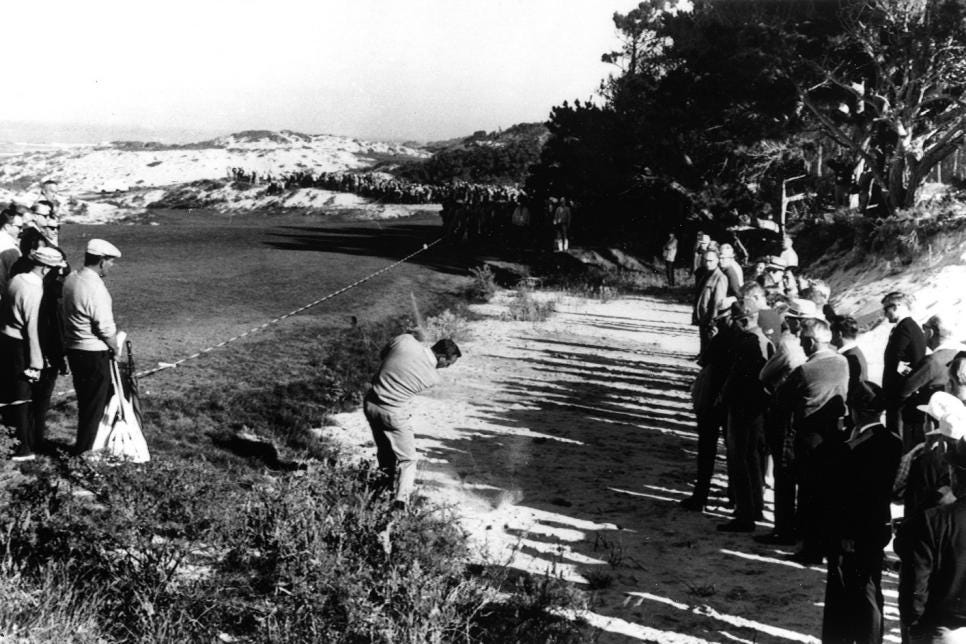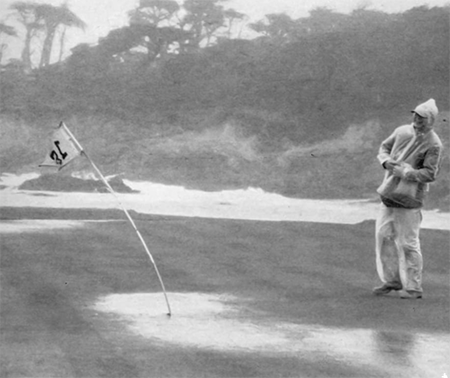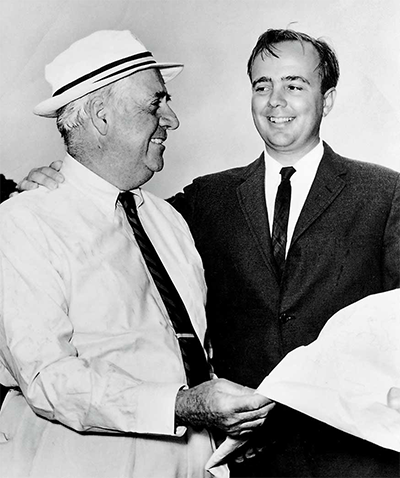This Clambake Had Controversy, Unbelievable Weather, and a Dream Leader Board
The three top players on the PGA TOUR sat atop the leader board while controversy swirled around the new course, Spyglass Hill, as wind and rain pummeled the field
Very interesting week with the PGA TOUR starting on a Wednesday and finishing on a Saturday so as to clear the television schedule for the NFL Divisional Championships on Sunday. We changed our poll to a head-to-head matchup for the week and it looked like a bad move after the first round. Jon Rahm opened up with a 73 and looked to be in danger of missing the cut, nevermind beating Justin Thomas, his opponent in our poll.
Rahm roared back with a second round 67 and then followed that up with a third round 66 and now held a share of the lead. Thomas followed a first round 68 with a second round 74 and a third round 73 and did not factor in the finish. Jon Rahm shocked us all as he failed to hold onto his lead and finished with a fourth round 74 and a tie for 7th place (but he did win our poll!). Congratulations to Max Homa for winning in his home state with a final round 66.
Clip You Might Have Missed
This week the PGA TOUR moves to the Monterey Peninsula for one of our favorite weeks on the schedule for the AT&T Pebble Beach Pro-Am, once known as the Bing Crosby National Pro-Am. It was first played on the Monterey Peninsula in 1947 after it was played in San Diego from 1937.
We’ve got a fun spin on our Head to Head Matchup poll. Scroll down to pick.
Get the Tour Backspin Newsletter delivered to your email inbox for FREE.
POLL
Who Wore it Better?
Phil Mickelson returned to Twitter with a roast of Sam Ryder’s pants.

So, in this week’s Head to Head Matchup, we want to know who wore it better?
Mickelson?
Or Ryder?
Tour Backspin Head to Head Matchup is for entertainment value only.
Happy 100th birthday to World Golf Hall of Fame member, and Masters Champion Jack Burke, Jr.
We’re turning back to 1967 when Spyglass Hill replaced Monterey Peninsula Country Club in the Crosby rotation. Scroll down to learn more.
We love to get feedback! Let us know what you think about Tour Backspin and the stories we tell. Email me at larry@tourbackspin.com, or let me know in the comments.
Listen to The Tour Backspin Show podcast HERE or on Spotify, or on Amazon Music and Apple Podcast.
If you like golf history, check out the Your Golfer’s Almanac podcast. Host Michael Duranko celebrates birthdays, milestones, and other accomplishments that occurred on the day in golf history. Listen HERE.
Congratulations to Bill Badger for correctly answering last week’s WHAT HOLE IS IT? The featured hole was #18 at Rancho Bernardo Inn Golf Course in San Diego. Bill beat out one other correct answer. Check out the new 2023 leader board and scroll down for your chance to win in this week’s WHAT HOLE IS IT?
We’re playing Bing Crosby Trivia this week in the Tour Backspin Quiz. Scroll down to play.
This week’s ad features the national television broadcast schedule for the 1967. Scroll down to see.
Did you miss a previous newsletter? You can view it HERE. Forward this email to a friend. Was this newsletter forwarded to you? You can sign up HERE.
Okay, we're on the tee, let's get going.
Robert Trent Jones and Bing Crosby Defend Spyglass Hill

It is June 1966, and the organizers of the Bing Crosby National Pro-Am made the dramatic announcement that Spyglass Hill, a new course designed, and built by, Robert Trent Jones, would replace the Monterey Peninsula Country Club as one of the three courses used in the tournament. The course had only opened a few months earlier, in March, and many wondered if it would be ready for a PGA tournament by January of 1967.
It may have been more prudent to wait a year, give the course a chance to grow into shape, but everyone concerned, from the architect to the Crosby brothers (Bing’s brother Larry was the tournament chair), were so excited about the course that they wanted to show it off. The PGA was not so eager to sign-off on the new course, though.
“It will require two years to prepare it properly for tournament play,” Jack Tuthill, the PGA supervisor of tournaments wrote to Robert T. Creasey, the executive director of the PGA, after an inspection tour in September of 1966. “Certainly, it cannot be wisely considered for the 1967 tournament.”
That assessment did not sit well with either the Crosby organizers, or with Robert Trent Jones, and they fired back with a letter of their own to Creasey.
“As long ago as March of this year,” the letter stated, “the architect for our Spyglass Hill Golf Course, Mr. Robert Trent Jones, reported that the course could be properly prepared for the 1967 Crosby Tournament. Mr. Jones and his staff have repeated their conclusion upon continued inspection of the course many times, the last occasion being approximately a month and a half ago. Our Manager of Golf, Mr. Roger Larson, is also confident that the course can be properly prepared for the Crosby Tournament in 1967.”
By November, the clash between the Crosby organizers and the PGA was made public in the press. Bing Crosby added fuel to the fire when he suggested to the PGA brass that he would withdraw his sponsorship of the tournament if Spyglass was not included in the 1967 tournament.
Crosby had the backing of Samuel Morse, the owner of the Pebble Beach properties.
“I have more experience in tournament play and the conditioning of golf courses than Mr. Creasey, or probably anybody else in the country, putting it modestly,” Morse wrote to the Crosbys, “and the Spyglass Hill Course is in perfect condition. If there are any complaints, it won’t be the fault of the course.”
In the end, the PGA bowed to the pressure being applied by the Crosbys, Morse, and Jones, and Spyglass Hill became part of the Crosby rotation. The PGA touring pros were excited but anxious to play the new course.
“That’s all we talked about at the San Diego Open last week,” Billy Casper said upon his arrival on the Monterey Peninsula for the 1967 event.
Robert Trent Jones was known as “the architect the pros love to hate” because of the difficult courses he designed and the courses he worked on in his role as “the Open doctor” where he tweaked courses that were built in the Golden Age of golf course architecture making for a modern U.S. Open setup. This work was not always met with accolades from those who played them under the pressures of a major championship.
“They just ought to hang the man who designed it. Ray Charles could have done a better job.”
Once the players arrived in the Del Monte Forest for the 1967 Crosby, the complaints started to cascade with many pros openly expressing their disdain for the course.
“They just ought to hang the man who designed it,” Lee Trevino stated. “Ray Charles could have done a better job.”
The critical comments included many concerning the condition of the course.
“I can’t think of any course we’ve played on the Tour during the last couple years that is in such bad condition. Several of the holes are unfair, and the contour of the greens is too severe.”
“The first five holes will kill you!” veteran Dutch Harrison moaned. “The course isn’t ready. They should give it time to grown up.”
Jack Tuthill told reporters, “I can’t think of any course we’ve played on the Tour during the last couple years that is in such bad condition. Several of the holes are unfair, and the contour of the greens is too severe.”
Bing Crosby stubbornly dug in his heels defending the use of the course. But he did warn the amateurs playing in the event that Spyglass was extremely difficult and that they should pick up their balls on any holes where they had shot themselves out of any chance to help their team. He also warned the pros that Spyglass would play six strokes harder than the Monterey Peninsula Country Club. Crosby bet Jack Nicklaus “that he can’t break 72 from the tiger tees at Spyglass.” Nicklaus failed in his first practice round shooting a 76 but did manage to take Crosby’s money by shooting a 70 in his second practice round.
In one concession to the condition of the course, it was decided that “winter rules” would be employed on any ball that came to rest in the fairway, but shots into the rough would be played as it lied.
The weather for Thursday’s opening round was partly cloudy with light breezes and temperatures in the 60s and the scoring reflected the benign conditions. Four pros shot 70 on Spyglass: Bob Charles; Jack Burke, Jr.; journeyman pro Jerry Pittman; and twenty-five-year-old Jim Colbert.
Jack Nicklaus cruised to a three-under-par 69 on Pebble Beach in the first round and stood one stroke back of the leader, Joe Carr, who shot a 68 at Cypress Point.
The weather on Friday for the second round turned dark and nasty with cold temperatures. The difficulty of Spyglass Hill, along with the course conditions, were exacerbated by the foul weather. Scores ballooned with the pros shooting scores into the high 70s and 80s. Joe Carr followed up his first round of 68 at Cypress with an 82 at Spyglass.
Despite the windy conditions, Jack Nicklaus scorched the front nine at Cypress Point shooting a five under 32. He then added pars on the first five holes of the back nine. It is difficult to determine exactly where you stand on the leader board at the Crosby with the different courses being used, but it was estimated that Nicklaus had built up an eight stroke lead by the time he’d reached the 15th tee.
But this is where the course meets the wind and the sea. Hitting into the stiff wind on the 15th, Nicklaus watched as his six-iron shot on the 113-yard par-3, normally a wedge or 9-iron shot, fell short and into a front bunker. He wound up with a double bogey. On the infamous 16th, he tried to play it safely to the left of the par-3 green and again came up short, failing to carry the water and resulting in another double bogey.
On the 17th hole, his drive was pushed 50 yards offline by the wind resulting in an unplayable lie and a third straight double bogey. Even so, the day ended with Nicklaus holding a two-stroke lead on the field. His closest pursuers included Jerry Pittman, Steve Oppermann, Bob McCallister, and Jim Colbert. Billy Casper was four strokes back and Arnold Palmer was seven strokes behind Nicklaus.
“When I got there,” he recalled afterward, “the sand was so thick, I couldn’t find anyone. I figured if I couldn’t see the players, it was time to quit.”
Saturday’s weather made Friday’s weather look like a walk in the park. Heavy rains and 60 mile-per-hour winds made the day impossible to play and ruined any hope that Spyglass Hill would be shown in a favorable light. By noontime, only two scores had been turned in—both 87s.
Jack Tuthill ventured out to the 7th hole at Pebble, a short par-3 on a promontory. “When I got there,” he recalled afterward, “the sand was so thick, I couldn’t find anyone. I figured if I couldn’t see the players, it was time to quit.” Play was suspended with the decision to complete the tournament on Sunday and Monday.

Despite what Sam Morse, the Crosbys, and the Jones Team had said about how well Spyglass would drain and hold up in bad weather, Sunday’s final round found the course very soggy and it was drying out much slower than the other two courses. Jack Nicklaus buried his approach shot to the 604-yard, par-5 first hole in the quagmire that the sand surrounding the green had become. He tried to hit out of what felt like quicksand and wound up with a double bogey. He was able to rally for a 74, one of the better rounds shot at Spyglass, but had surrendered his lead to Billy Casper, who played Pebble shooting a three-under 68.
Arnold Palmer finally woke up and made his move on Sunday. After opening with rounds of 74 at Spyglass on Thursday and a 75 at Pebble on Friday, he roared back with a 67 at Cypress Point on Sunday. The round was quintessential Palmer and included six birdies. On the 14th hole, he provided the kind of fireworks that his “army” had come to love. He bounced his approach shot down a bank and then didn’t catch his wedge chip shot cleanly resulting in the ball rolling down the bank and back to his feet. He hit his wedge again and this time, the ball flew up and onto the green before rolling into the hole for a par. His fine round put him into a tie with Nicklaus, one shot back of Casper. The Crosby now had a dream leader board that featured the three top stars of the game.
In the final round on Monday, Casper played steady golf, but it was no match for Jack Nicklaus who made five birdies on the back nine, shot a 68 and walked away with the title. Palmer hit two shots out-of-bounds on the 14th hole and recorded a nine that ended any hopes he had. Casper shot a 74 and ended up five shots behind Nicklaus.
“They did not live up to the commitments they made to us last year about conditions at Spyglass.”
Spyglass Hill received a great deal of criticism upon its debut in the Crosby. One amateur may have had the best one-liner about the course saying, “We played the course under some unfortunate conditions: It was open.”
In the end, Jack Tuthill was correct while the PGA, Sam Morse, and Robert Trent Jones, were incorrect. Spyglass Hill was simply not ready to host a PGA tournament. Jones later acknowledged as much, as did Bing Crosby, who voiced concerns about returning to Spyglass the next year.
“They did not live up to the commitments they made to us last year about conditions at Spyglass,” Crosby said in a statement to the press. “Unless they are improved, I seriously doubt the course will be approved for the tournament in January.”
Spyglass Hill conditions did improve as it matured and the drainage issues that were so apparent in 1967 were eventually corrected. Spyglass Hill enjoys a spot near the top of any golfer’s “bucket list” and is enjoyed by players at the AT&T Pebble Beach Pro-Am, (what the Crosby has evolved to) to this day.
(h/t to James R. Hansen and his book A Difficult Par, the biography of Robert Trent Jones for the research materials used in this week’s story.)
Robert Trent Jones represented the family business at the 1967 Bing Crosby National Pro-Am. Find out why in this week’s bonus story.
We’re going back to 1967 for the hits on this week’s playlist. Listen HERE.
Please help us grow by forwarding this email to a friend who would enjoy it. Thanks.
Enjoy!
Larry Baush
Follow us on Facebook, Instagram, Twitter and YouTube
Tour Backspin Playlist
Thanks for reading! Please let your family, friends and colleagues know they
can sign up for email delivery of this free newsletter through this link.
Bonus Story
Robert Trent Jones, Jr., known as Bobby, represented the family firm at the 1967 Crosby, playing in the pro-am with his partner Larry Ziegler. His father, Robert Trent Jones, Sr. cited work obligations that required him to be out of the country as the reason for his absence. But Bobby disclosed that that wasn’t the real reason he wasn’t in the field on the Monterey Peninsula that week.
“Dad didn’t want to look bad on his own course,” Bobby said.
Bobby and Ziegler missed the cut and Bobby spent the rest of the weekend walking in the gallery and giving interviews where he defended the course and the condition of the course.
“This course isn’t in any worse condition than some the pros play on tour,” Bobby declared.
Jack Tuthill did not agree. “That’s not so,” he said. “I wish Mr. Jones would name one.”

WHAT HOLE IS IT?
Are you on the leader board?
Tour Backspin Quiz |Bing Crosby Trivia
What were Bing Crosby’s last words?
Answer below
What is Hip?
Golf Fashions in 1967. Mustard must have been the color of the year. Or, maybe ketchup.
Pro Pointer
Blind Shot
Click for something fun. 👀
Tour Backspin Quiz Answer:
Bing Crosby was playing golf in Madrid, Spain on October 14th, 1977. It is widely believed that upon finishing his round, he spoke his last words of “That was a great game of golf, fellas,” before collapsing suffering from a heart attack. But Valentin Barrios, the general manager of the La Moralaeja Golf Course relates that just before Crosby collapsed, he said “Let’s go have a Coca-Cola.”





















